The Taiwan High Speed Rail Corp (THSRC) this week unveiled its next-generation trains, procured from Japan, featuring new designs aimed at enhancing passenger comfort.
The Taipei-based high-speed rail operator signed a rolling stock procurement contract with Hitachi Toshiba Supreme Consortium (HTSC) in 2023 as part of its plan to meet rapidly increasing travel demand.
The two companies also signed two supplementary deeds last year and this year to finalize the details of the train design.
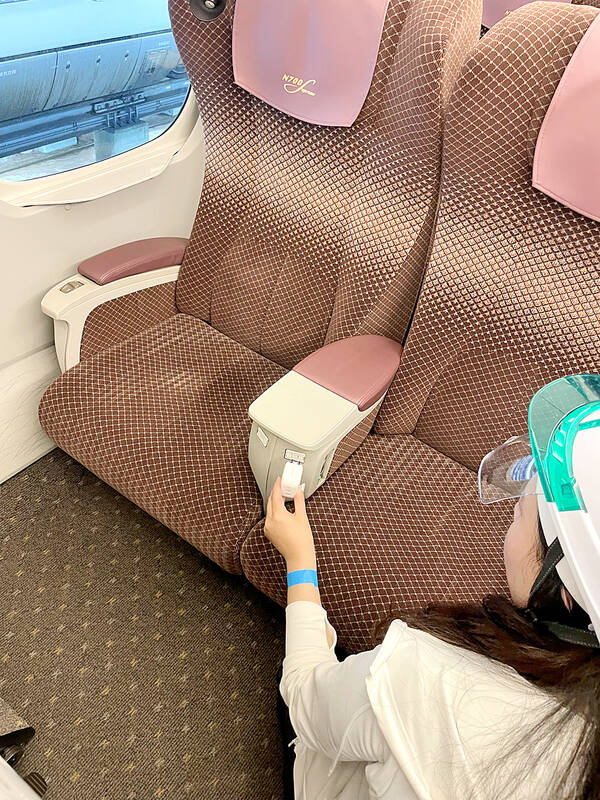
Photo: Shelley Shan, Taipei Times
The N700 Supreme Taiwan (N700ST) trains are based on the N700 Supreme series already operating between Tokyo and Kyushu, but feature further enhancements, the company said.
On Monday, THSRC invited Taiwanese media to Central Japan Railway Company’s Oi Rolling Stock Depot in Tokyo — which handles Shinkansen maintenance and inspections — using an N700S train to showcase several of the new features planned for the N700ST.
Taiwanese journalists yesterday boarded a chartered N700S from Tokyo to Osaka — Japan’s most profitable railway line — to experience firsthand several facilities that would be included in the NT700ST.

Photo: Shelley Shan, Taipei Times
The NT700ST uses advanced materials that cut power consumption by about 20 percent, the company said, adding that it carries autonomous battery units, allowing the train to coast safely to a stop during a power outage.
Emergency braking distance has been shortened from 4km to 3.2km, improving safety in earthquakes or other emergencies, while the batteries can power emergency lighting for an additional 30 minutes after an outage, it said.
Meanwhile, in-car noise levels would be about 10 percent lower through the use of a fully enclosed inter-car structure and enhanced soundproofing, THSRC said.
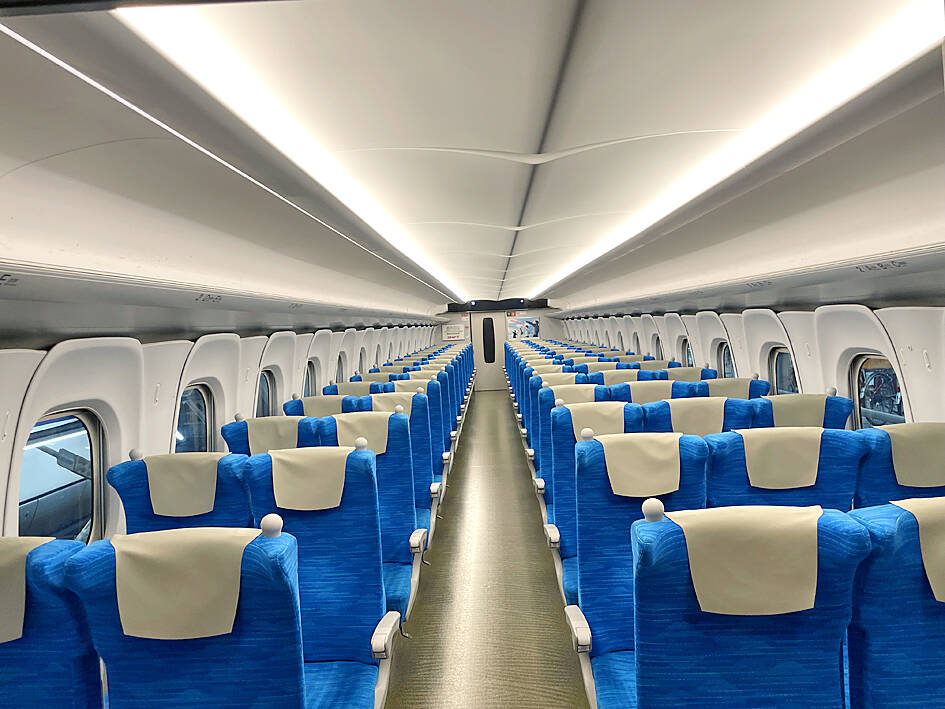
Photo: Shelley Shan, Taipei Times
A fully active suspension system, installed in designated cars, is designed to improve ride comfort by up to 30 percent, it said.
THSRC has ordered 12 trainsets from HTSC, each consisting of 12 carriages, at a total cost of more than ¥124 billion (US$838.6 million).
The first set is scheduled to arrive in Taiwan in August next year, with full operations slated for the second half of 2027.
Once all 12 N700ST trainsets are in service, peak-hour frequency on the line would increase by 25 percent, the company said.
The new design also introduces a “dual supreme wing” nose section, featuring a flatter, more aerodynamic profile to reduce noise and drag when entering tunnels, it said.
The headlights have been enlarged and upgraded with LED bulbs to improve energy efficiency, it added.
Inter-carriage doors would open by utilizing automatic light-sensing operation, eliminating the need for manual activation, the company said.
The doors would be equipped with fully transparent windows, consistent with the 700T series, enabling clear visibility for passengers inside and outside the carriage, it said.
The train windows would be slightly smaller than those of existing models to reduce aerodynamic drag and further insulate against noise, it added.
All seats would be equipped with a 110V power outlet integrated into the armrest. Seat-back trays would be enlarged and fitted with additional hooks, both designed with a soft-close mechanism to minimize disturbance to the passenger ahead, it said.
Business-class passengers would also have access to an additional tray stored in the armrest, it said, adding that in both economy and business classes, seats would sink slightly as the backrest reclines, enhancing comfort.
Business-class seats would feature higher backrests and wraparound armrests, creating a more private, enclosed feel, it said.
While the N700S series uses blue upholstery in economy class and dark red in business class, the new N700ST would have green seats for economy and brown for business, the company said.
Passengers would benefit from larger in-train display panels, with destinations shown in bigger fonts and distinct colors for easier readability, the company said.
Onboard lavatories would be redesigned as standalone units relocated to vestibules, complete with a curtain for added privacy, it said.
All lavatories would feature bidet toilets with a user-friendly control panel.
For safety, surveillance cameras would be installed above passenger emergency intercoms at the front and rear of each car. When an intercom button is pressed, train staff would be able to view the situation in real time, enabling timely response and assistance, the company said.
The overhead luggage racks, which are made from recycled aluminum alloy sourced from retired Shinkansen 700-series trains, would be deeper to accommodate 26-inch (66cm) suitcases, it said.
The air-conditioning system would also be upgraded with vents integrated into the car walls, it said.
Curved vanes would direct airflow toward ribbed ceiling panels, improving circulation and ensuring a more comfortable cabin environment, it added.

NEW AGREEMENT: Malaysia approved imports last year after nearly two years of negotiations and inspections to meet quarantine requirements, officials said Up to 3.6 tonnes of pomeloes from Taiwan cleared Malaysian customs on Friday, in the first shipment of Taiwanese pomeloes to Malaysia. Taiwan-grown pomeloes are popular in domestic and overseas markets for their tender and juicy taste, the Ministry of Agriculture’s Animal and Plant Health Inspection Agency said. The fruit is already exported to Japan, Canada, Hong Kong, Singapore and the Philippines, it added. The agency began applying for access to the Malaysian market in 2023, compiling data on climate suitability, pests and diseases, and post-harvest handling, while also engaging in nearly two years of negotiations with Malaysian authorities and submitting supplementary
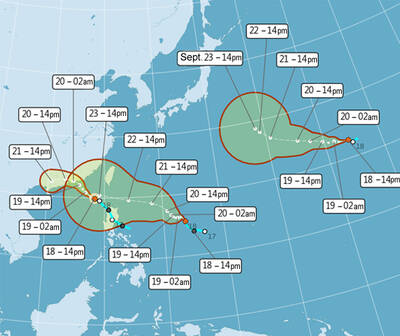
PEAK MONTHS: Data showed that on average 25 to 27 typhoons formed in the Pacific and South China seas annually, with about four forming per month in July and October One of three tropical depressions in the Pacific strengthened into a typhoon yesterday afternoon, while two others are expected to become typhoons by today, Central Weather Administration (CWA) forecaster Lee Ming-hsiang (李名翔) said yesterday. The outer circulation of Tropical Depression No. 20, now Typhoon Mitag, has brought light rain to Hualien, Taitung and areas in the south, Lee said, adding that as of 2pm yesterday, Mitag was moving west-northwest at 16kph, but is not expected to directly affect Taiwan. It was possible that Tropical Depression No. 21 would become a typhoon as soon as last night, he said. It was moving in a
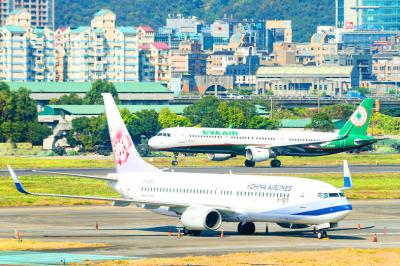
Tigerair Taiwan and China Airlines (CAL) today announced that several international flights were canceled or rescheduled due to Typhoon Ragasa. The Central Weather Administration (CWA) has maintained sea and land warnings for the typhoon. Its storm circle reached the Hengchun Peninsula (恆春半島) on Taiwan's southern tip at 11am today. Tigerair Taiwan said it canceled Monday's IT551/IT552 Taoyuan-Da Nang, IT606/IT607 Taoyuan-Busan and IT602 Taoyuan-Seoul Incheon flights. Tomorrow, cancelations include IT603 Seoul Incheon-Taoyuan, as well as flights between Taoyuan and Sapporo, Osaka, Tokyo Narita, Okinawa, Fukuoka, Saga, Tokyo Haneda, Nagoya, Asahikawa and Jeju. On Wednesday, the IT321/IT322 Kaohsiung-Macau round-trip would also be canceled. CAL announced that today's
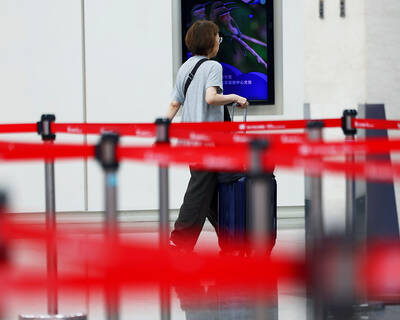
About nine Taiwanese are “disappeared,” detained, or otherwise deprived of freedom of movement in China each month, the Mainland Affairs Council (MAC) said yesterday. Between Jan. 1 last year and Aug. 31 this year, 188 Taiwanese travelers went missing, were detained and interrogated, or had their personal freedom restricted, with some questioned in airports or hotel lobbies, the council said. In a statement ahead of the Mid-Autumn Festival, the council urged people visiting China for any reason to be highly vigilant and aware of the risks. Of the reported cases, 50 people were “disappeared” after entering China, 19 were detained and 119 had